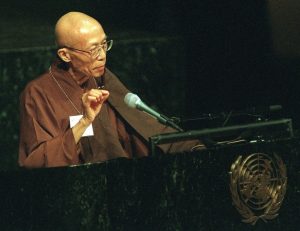This feature is part of a series from presenters at the Woodenfish Foundation’s recent conference on “Buddhism, Consciousness, and AI” held on 21–23 June in Taipei.

There is no denying that AI has become the most talked about technology in recent years. Its power and pervasiveness have led to a plethora of guidelines intended to ensure its safety and to safeguard the values and rights of people. A study by the AI Ethics Guidelines Global Inventory showed that there are as many as 167 such guidelines worldwide. However, this count was last completed in April 2020, a full four years ago, and there is every reason to believe that there are now many more.
What these guidelines do is mostly present a number of “ethical principles,” which manufacturers, engineers, and those involved with AI are expected to follow. They are not legally binding but they express concerns that are felt by many that AI needs to behave ethically—that is, AI systems are expected to protect people, safeguard their rights, and not harm people in any way.
These principles are shared by most AI ethics guidelines. A study by Anna Jobin and her team, which analyzes 84 AI ethics guidelines, all of which are in the West and Japan, shows that among the most shared principles are transparency (that the work of AI systems must not be in a “black box,” unable to say how they arrive at their solutions), justice and fairness (that the systems should be fair and non-discriminatory), non-maleficence, responsibility, and privacy. Jobin and her team add further that no one principle is shared by all the guidelines they study. Thus, there are both similarities and differences among these guidelines
Another study that I conducted together with my research assistant Jerd Bandasak shows that, apart from these core principles, several principles are found in only a few guidelines. (Hongladarom and Bandasak, 2023) For example, the number-one principle in the Thai guideline, published by the Ministry of Digital Economy, states that AI systems must be used to enhance the economic competitiveness of the country. One wonders how economic competitiveness could be regarded as an ethical principle. But that shows how the framers of the Thai guideline think of what AI should be able to do in their own context.
Both the similarities and the differences in these AI ethics guidelines are interesting in their own right. As for the similarities, one wonders how much actual similarity there is when these guidelines are formulated and used in different social and cultural contexts. According to Michael Walzer, in Thick and Thin: Moral Argument at Home and Abroad (University of Notre Dame Press 2019), someone who watches on television demonstrators in a foreign land holding signs for “justice” may well sympathize with them, but when it comes to the nitty-gritty task of spelling out what justice actually stands for, there are bound to be disagreements.
As for the differences, it shows that what is taken to be ethical principles do indeed vary from one culture to another. The drafters of the Thai guideline may act in good faith, genuinely believing that economic competitiveness is an ethical principle, and so do their Chinese counterparts, who in one of the Chinese guidelines specify that “harmony” is among the principles that are part of AI ethics (Hongladarom and Bandasak, 2023). All these are fine examples of how diverse the world is, and this is all to be celebrated.
Nonetheless, there seem to be certain instabilities in either the similarities or the differences in these guidelines. These instabilities stem from the fact that theory is missing from them. It is a clear fact that these guidelines are not intended for professional philosophers; they do not have to specify the rationale or complex argumentation behind their normative pronouncements. But without a theory, one is at a loss to see why certain principles are there in the first place. The framers of the guidelines may not be philosophers—indeed most of them are not—but the fact that some principles found their way into most guidelines seems to show that at least some kind of theory is in their minds, even though they might not have spelled them out clearly. I believe that it is the task of a philosopher to spell this out.
Nonetheless, there are many ethical theories in the Western tradition, such as the Kantian and utilitarian theories, and there is also the virtue ethics tradition. The choice of these theories is difficult enough. But the more difficult problem lies in the fact that these are Western traditions—no matter which theory one chooses, the problem is how to use the theory in other cultural contexts, such as in Asia and other non-western regions.
The problem with the Kantian theory is that it is formal and abstract. This poses a problem when someone tries to plant it on Asian soil, whose ethical tradition is opposite to being formal and abstract. The utilitarian theory puts exclusive emphasis on pleasure or “utilities,” thus it is lacking in the meaningful aspects of people’s lives, precluding the attainment of genuine happiness. In this respect, I would like to propose that the Buddhist ethical theory does a better job as the theory of AI ethics, at least in Asia. As for the Western virtue ethics tradition, it is more similar to the Buddhist theory than either the Kantian or utilitarian theories. But the difference between Western virtue ethics and Buddhist ethics is that the latter has a well-developed metaphysical theory, such as emptiness and non-self, which seems to make for a clearer program of ethical cultivation.
In any case, the advantage of the Buddhist theory is that it pays a lot of attention to the alleviation of suffering in a way that is also spiritual and meaningful because the suffering here also includes the suffering of conditioned existence (saṅkhāradukkhatā), which is deeply connected to the nature of things. Cessation of this kind of suffering can be accomplished through the realization of emptiness, i.e., the realization that things are void of their inherent nature.
The relation of all this with AI ethics is that the realization that things are empty of their inherent nature could become a premise on which normative judgments in AI ethics are made. This realization is the basis for the program toward the cessation of all suffering taught by the Buddha. One starts by seeing that all sentient beings want happiness and they want to avoid suffering. The only way to permanently avoid suffering is to realize that all suffering stems from a misapprehension of the true nature of reality. Thus, a program of ethics that is based on a correct understanding of the nature of reality should serve as a common ground for various cultures when they search for shared normative understanding. In other words, in a world where there is a diversity of cultures, but where these cultures interact intensively through globalization and especially through the fact that AI has brought them even more tightly together, the Buddhist program can become a basis for the kind of value system that is shared by everyone. This is because all cultures share the same empirical world, and the same underlying material reality—thus, an ethical system that is rooted in this reality should be the fulcrum point where common agreement among cultures can be found.
This common fulcrum point does not have to be couched in Buddhist terminology. As is the case with now-popular meditation sessions and apps, the language used in these sessions does not need to refer to Buddhism at all. As long as the sessions and apps achieve what they are supposed to do, then everything is fine. Hence, the project of looking for common ground or functional universality, in normative judgments, does not have to refer to Buddhism, but it needs to refer to the fact that we all share this world together, and that values should be based on the premise that everyone wants to avoid suffering and attain genuine happiness.
All this, however, does not obviate the need to recognize diversity among cultures. At one level, all humans want to avoid suffering, but their material conditions in, say, Thailand, may differ from those in Europe or China. In these more specific cases, certainly more specific normative judgments are needed, ones that are adapted to local contexts. This can explain why the Thai framers of their AI ethics guideline put economic competitiveness as their number one principle. Official discourses by the Thai bureaucracy have been dominated by economic development for decades—thus, it is understandable that when these framers think about what AI should do, they would think first of the issue.
As AI systems continue to be used by all sectors all around the world, and as they continue to pervade all our lives, we surely need a global regulatory framework that is agreed to by all cultures. I have proposed that a Buddhist, or Buddhist-based, system that grounds normative judgments on reality should be adopted. Of course, this cannot be taken to mean that everybody must become a Buddhist. That is patently impossible and also contrary to the Buddha’s intention. On the contrary, it means that a basis for a global regulatory system can be found which should do a better job at securing agreement and understanding among diverse cultures. One only needs to point out that everyone wants happiness and wants to avoid suffering.
References
Hongladarom, Soraj and Bandasak, Jerd. 2023. “Non-western AI ethics guidelines: implications for intercultural ethics of technology.” AI & Society. Available at https://link.springer.com/article/10.1007/s00146-023-01665-6
See more
AI Ethics Guidelines Global Inventory (Algorithm Watch)
The global landscape of AI ethics guidelines (Nature)
Digital Thailand: AI Ethics Guideline (ETDA)
Related features from BDG
Seeding Peace in the Cloud
Building Bodhisattvas: Toward a Model of Powerful, Reliable, and Caring Intelligence
Consciousness, Attention, and Intelligent Technology: A Karmic Turning Point?
In a World of Human Ignorance, Can Artificial Intelligence Help?
Dharma, Perfect Knowledge, and Artificial Intelligence
Does Artificial Intelligence Have Buddha-nature?
The Rise of Artificial Intelligence and What it Means for Our Jobs














The Golden Rule Machine Translated